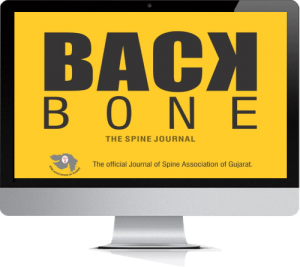Inter-relation of Hypocalcemia with Established Osteoporosis and DXA Analysis – A Prospective Study of 100 Indian Subjects
Volume 1 | Issue 1 | October 2020-March 2021 | page: 19-22 | Bharat R. Dave, Himanshu Kulkarni, Devanand Degulmadi, Shivanand Mayi, Ravi Ranjan Rai, Kirit Jadav, Ajay Krishnan
Authors: Bharat R. Dave [1], Himanshu Kulkarni [1], Devanand Degulmadi [1], Shivanand Mayi [1], Ravi Ranjan Rai [1], Kirit Jadav [1], Ajay Krishnan [1]
[1] Stavya Spine Hospital and Research Institute, Near Nagari Eye Hospital, Mithakhali, Ellisbrige, Ahmedabad, Gujarat, India .
Address of Correspondence
Dr. Ajay Krishnan,
Stavya Spine Hospital and Research Institute, Ahmedabad, Gujarat, India .
E-mail: drajaykrishnan@gmail.com
Abstract
Purpose: The purpose of the study was to screen the presence of hypocalcemia and clinical signs specific to hypocalcemia in dual-emission X-ray absorptiometry proven osteoporotic patients and also to analyze variations of T scores at specific anatomical regions in lumbar spine and hip.
Type: Prospective cohort.
Materials and Methods: One hundred patients who had T score of <−2.5 at any of the lumbar levels or in total lumbar T score were selected. Ionic calcium levels (normal – 1.1–1.135 mmol/L) of each patient were calculated. Trousseau’s sign and Chvostek’s sign were checked. Analysis of T scores was done for each patient.
Results: Twelve out of 100 patients had hypocalcemia. Out of whom, only one patient had positive Trousseau’s sign and none had Chvostek’s sign present. In normocalcemic patients (n = 88), seven patients had positive Trousseau’s sign and three had Chvostek’s sign present. Average total lumbar T score of 100 patients was −3.0 (±1.1 SD). After calculating the averages, the L3 had least T score of −3.3 (±0.9 SD) and L1 had highest T score of −2.5 (±1.3 SD), respectively. Twenty-seven patients had total hip T scores <−2.5 and 72 patients had T scores <−2.5 at Ward’s triangle. Similarly, average total hip T score of 100 patients was −2.0 (±1.6 SD); average T score at Ward’s angle was much lower at −2.9 (±1.4SD).
Conclusion: L3 vertebra and Ward’s triangle are most sensitive indicators of osteoporosis. Although theoretically unlikely, hypocalcemia can be present in osteoporotic patients. Trousseau’s sign and Chvostek’s sign may be present in patients with established hypocalcemia; however, their absence does not rule out the diagnosis.
Keywords: Osteoporosis, hypocalcemia, T score, ward’s triangle.
References
1. Mithal A, Dhingra V, Lau E, Stenmark J, Nauroy L. The Asian Audit: Epidemiology, Costs and Burden of Osteoporosis in Asia. Nyon, Swizterland: International Osteoporosis Foundation; 2009.
2. Osteoporosis prevention, diagnosis, and therapy. NIH Consens Statement 2000;17:1-45.
3. Kanis JA. Assessment of fracture risk and its application to screening for postmenopausal osteoporosis: Synopsis of a WHO report. WHO study group Osteoporos Int 1994;4:368-81.
4. Blake GM, Fogelman I. The role of DXA bone density scans in the diagnosis and treatment of osteoporosis. Postgrad Med J 2007;83:509-17.
5. Boden SD, Kaplan FS. Calcium homeostasis. Orthop Clin North Am 1990;21:31-42.
6. Peacock M. Calcium metabolism in health and disease. Clin J Am Soc Nephrol 2010;5:S23-30.
7. Li Z, Kong K, Qi W. Osteoclast and its roles in calcium metabolism and bone development and remodeling. Biochem Biophys Res Commun 2006;343:345-50.
8. Sava L, Pillai S, More U, Sontakke A. Serum calcium measurement: Total versus free (ionized) calcium. Indian J Clin Biochem 2005;20:158-61.
9. Urbano FL. Signs of hypocalcemia: Chvostek’s and Trousseau’s signs. Hosp Physician 2000;36:43-5.
10. Shoback D, Marcus R, Bikle D. Metabolic bone disease. In: Greenspan FS, Gardner DG, editors. Basic and Clinical Endocrinology. 3rd ed. Los Altos, CA: Lange Medical Publications; 2004. p. 324.
11. Schaaf M, Payne CA. Effect of diphenylhydantoin and phenobarbital on overt and latent tetany. N Engl J Med 1966;274:1228-33.
12. Watts NB. Postmenopausal osteoporosis: A clinical review. J Womens Health (Larchmt) 2018;27:1093-6.
13. Garg MK, Kharb S. Dual energy X-ray absorptiometry: Pitfalls in measurement and interpretation of bone mineral density. Indian J Endocrinol Metab 2013;17:203-10.
14. Ramos RL, Armán JA, Galeano NA, Hernández AM, Gómez JG, Molinero JG. Absorciometría con rayos X de doble energía. Fundamentos, metodologia y aplicaciones clínicas. Radiologia 2012;54:410-23.
15. Blake GM, Fogelman I. An update on dual-energy x-ray absorptiometry. Semin Nucl Med 2010;40:62-73.
16. Duboeuf F, Pommet R, Meunier PJ, Delmas PD. Dual-energy X-ray absorptiometry of the spine in anteroposterior and lateral projections. Osteoporos Int 1994;4:110-6.
17. Yoshihashi AK, Drake AJ, Shakir KM. Ward’s triangle bone mineral density determined by dual-energy x-ray absorptiometry is a sensitive indicator of osteoporosis. Endocr Pract 1998;4:69-72.
18. Liu X, Qian ZY, Feng YS, Li HL, Xu YJ. Comparison of differences between hip and lumbar bone mineral density in dual energy X-ray absorptiometric data. Zhonghua Yi Xue Za Zhi 2013;93:191-4.
19. Ma XH, Zhang W, Wang Y, Xue P, Li YK. Comparison of the spine and hip BMD assessments derived from quantitative computed tomography. Int J Endocrinol 2015;2015:675340.
| How to Cite this Article: Dave BR, Kulkarni H, Degulmadi D, Mayi S, Rai RR, Jadav K, Krishnan A| Inter-relation of Hypocalcemia with Established Osteoporosis and DXA Analysis – A Prospective Study of 100 Indian Subjects | Back Bone: The Spine Journal | October 2020-March 2021; 1(1): 19-22. |
(Abstract) (Full Text HTML) (Download PDF)
.


